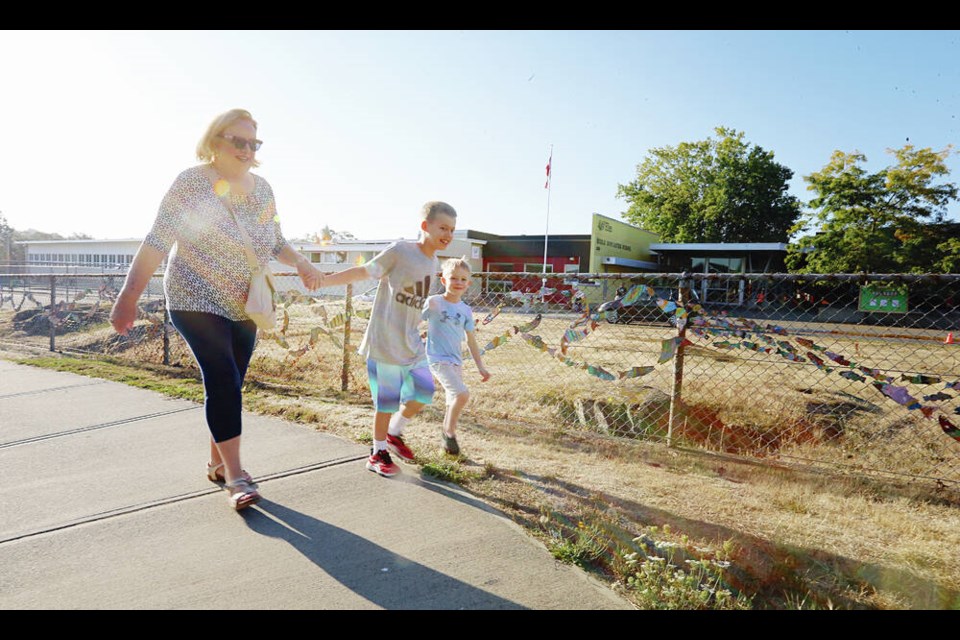This will be a special school year for Carter Mallett and his little brother, Brady.
The siblings are in the same school for the first time, with Carter in Grade 4 at École Doncaster Elementary and Brady starting kindergarten. Both are in French immersion.
“Brady’s done with daycare,” said grandmother Penny Cassidy, who was dropping them off for the first day of school on Tuesday. “They’ll have two years at the same school, which will be so nice for pickups.
“They’re excited to be together.”
Jane Armstrong, meanwhile, was dropping off Ellie, in Grade 5, and her brother, George, in Grade 1. Ellie will head to middle school in 2024, so they’re ready to enjoy their final year in one spot, Armstrong said.
Kaydence Harasemew, also a Grade 1 student at Doncaster, was full of excitement on Tuesday about the first day of school and seeing all her friends, said mom Chloe Rees. “We’ve been up since 6,” Rees said with a laugh.
Doncaster has about 420 students in kindergarten to Grade 5 and is one of 28 elementary facilities across the Greater Victoria School District — the largest district on Vancouver Island, with a student population of approximately 20,000.
The district has had a relatively stable population for the past few years, but others on the Island, like the Sooke and Nanaimo-Ladysmith districts, are seeing their numbers surge.
Growth in the Sooke district, which has about 12,000 students, has been among the highest per capita in the province for several years and is now exceeding projections, said superintendent Scott Stinson. Rapid development in the area has fuelled the increased student numbers.
“We were anticipating about 650 more students and we’re over 750 now, and continuing to receive registrations,” he said. “That’s always the challenge — we never really know what happens over the summer.”
Summer turned out to be busier than expected, with 220 registrations from July 1 to the end of August, Stinson said.
“Overall in the district we’re at 112 per cent capacity, so we are over-full in many places and we’ve moved a bunch of portables around this year.”
He said one of the full sites is Happy Valley Elementary, which has been at capacity for years, which has meant sending prospective students to other schools.
Growth has also meant moving portables over the summer to Ruth King Elementary, Journey Middle, Royal Bay Secondary and Edward Milne Secondary, Stinson said.
The portables at Royal Bay are needed despite a $29.9-million expansion that took the school from 800 to 1,400 seats in 2020. At the time, the move meant 10 portables were no longer needed.
The school is now at close to 1,600 students, Stinson said.
He said Belmont Secondary is also over capacity, with about 1,600 students, as well. “So we’re seeing significant pressure at the secondary level in those two schools.”
Both Royal Bay and Belmont were opened in 2015.
In the Nanaimo-Ladysmith School District, about 200 students are expected to be added to secondary schools for the 2023-24 year, said spokesperson Dale Burgos. Many of them are going to Nanaimo District Secondary, which is expected to end up with 1,680 students in a facility designed for 1,550.
Growth is not “by leaps and bounds” like some districts, he said, but has been constant in recent years. It has been accompanied by community growth in areas like north Nanaimo, which led to a four-classroom expansion at Dover Bay Secondary completed in 2022 that resulted in the removal of four portables.
Student numbers are expected to be firmed up by the end of September, Burgos said.
Stinson said that despite the Sooke district’s growth spurt, the number of teachers required is being maintained.
“I know there’s a challenge in the province, ” he said. “My colleagues in the north in particular continue to struggle, for us we seem to be OK.”
Some teaching areas, like French immersion, are more difficult to fill than others, Stinson said.
Construction is underway at the district’s newest school — SĆIȺNEW̱ SṮEȽIṮḴEȽ Elementary, pronounced “schee-ay-nuh ska-leetk-luth,” scheduled to open next September — and the district has hopes for more.
“We typically don’t hear from the Ministry of Education until March, when we get the official response to our capital plan,” Stinson said.



